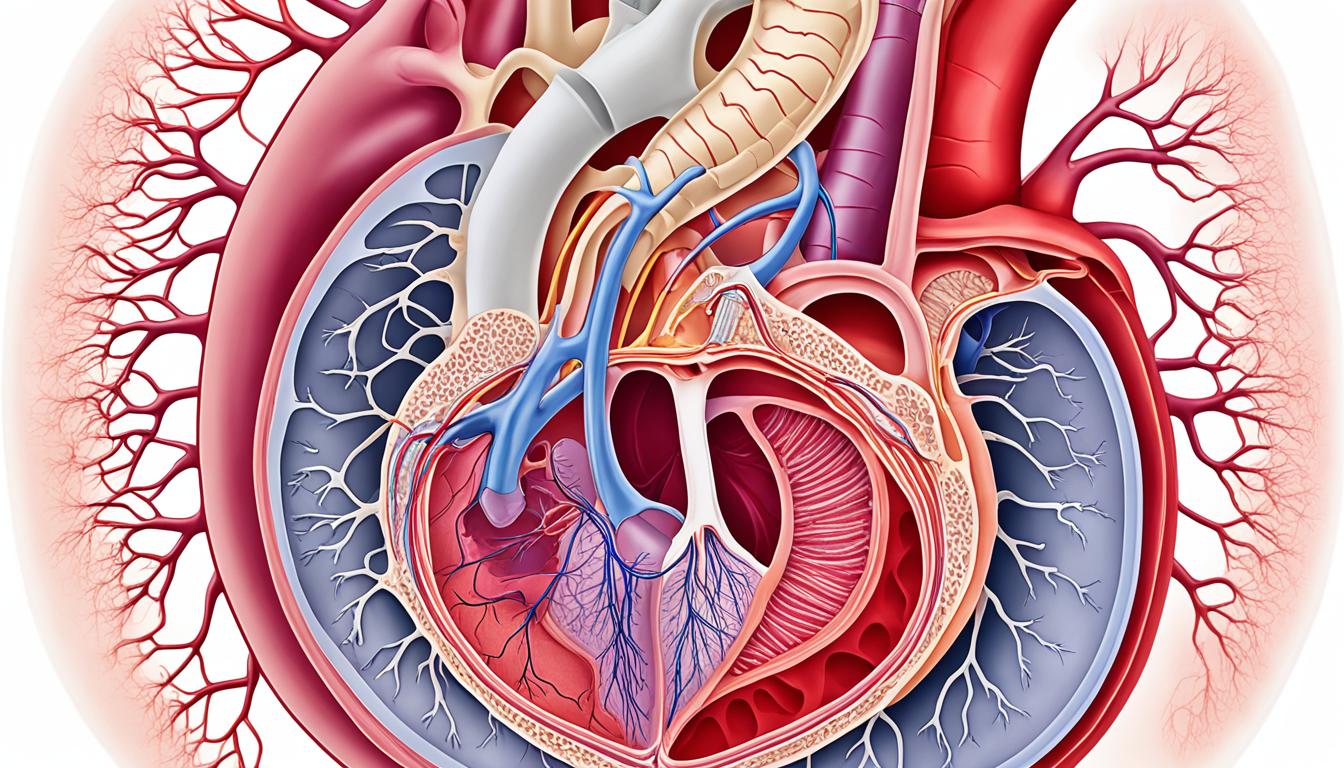Congenital mitral valve anomalies happen when the mitral valve doesn’t form right before birth. There can be simple defects or very complex problems with the valve. These issues may bring about serious symptoms and difficulties. A few common problems include stenosis, regurgitation, and issues with the valve’s parts such as leaflets or tendineae.
Key Takeaways:
- Congenital mitral valve anomalies are abnormalities in the structure of the mitral valve present at birth.
- These anomalies can cause severe symptoms and complications.
- Types of congenital mitral valve anomalies include stenosis, regurgitation, and abnormalities in the valve leaflets or chordae tendineae.
- Stem cell therapy and tissue engineering offer potential innovative approaches for treatment.
- These therapies aim to create living grafts that can actively grow and remodel alongside the recipient’s heart.
Risk Factors and Complications of Congenital Mitral Valve Anomalies
It’s key to understand the risks linked to congenital mitral valve anomalies for smart choices and early help. Lots of things can lead to these conditions. This includes certain genetic issues and health problems in the mother.
- Genetic factors: Certain genetic problems can raise chance of congenital mitral valve issues.
- Maternal conditions: Women with health problems like diabetes or high blood pressure might have higher risks.
- Medications and toxins: Some drugs and chemicals during pregnancy can harm the baby’s heart.
- Maternal infections: Infections like rubella while pregnant can also up the risk for heart issues in babies.
Keep in mind, not every case has clear risk factors and having risk factors doesn’t mean it’ll happen for sure. But knowing these can help doctors and mothers stay ahead, offering proper care.
The problems linked to these heart issues can change based on the type and how bad they are. Here are a few common issues:
- Heart failure: Severe issues can make the heart not pump well, leading to tiredness and water build-up in the body.
- Pulmonary hypertension: This makes pressure in the lung blood vessels rise, causing heart enlargement and low oxygen levels.
- Arrhythmias: The heart might beat irregularly due to the heart’s faulty structure, making it hard to keep a steady rhythm.
Early spotting and treating these issues matter a lot. Treatments might include surgeries to fix or replace heart valves. These aim to reduce issues and help the heart work better in kids with these problems.
| Treatment Options | Description |
|---|---|
| Pediatric Cardiac Surgery | This is a specialized surgery for children to fix heart abnormalities, which can include the mitral valve. It might involve repair or replacement to help blood flow right. |
| Valve Replacement Surgery | In this surgery, a bad mitral valve can be substituted with an artificial one. It’s done to improve blood flow and cut symptoms of these valve issues. |
| Mitral Valve Repair | Repairing the mitral valve is another option, if possible. It keeps the natural valve and could have better results over time. |
The Potential of Stem Cell Therapy for Congenital Mitral Valve Anomalies Treatment
Stem cell therapy and tissue engineering are new ways to treat heart issues from birth. They use stem cells to create living grafts. These grafts can grow and change with the heart, making them better than regular grafts.
Science plays a big part in making this all work. It uses special materials for the stem cells, letting them become the right kinds of heart cells. This makes it possible for the heart to work better.
This kind of therapy has a lot of promise. It could stop the need for many surgeries by not failing like traditional grafts do. Also, it might help fix the heart without the need for more tissue. As we learn more about these methods, using stem cells might become a normal way to treat heart problems at birth.
FAQ
Q: What are congenital mitral valve anomalies?
A: At birth, some people have problems with their mitral valve. This valve can have defects or be shaped wrong. It can lead to severe health issues.
Q: What are some common types of congenital mitral valve anomalies?
A: Common types of these issues are valve narrowing or leaking. Abnormalities in the valve’s parts like leaflets are also seen.
Q: What are the risk factors for developing congenital mitral valve anomalies?
A: Risk factors include family history and what the mother faced during pregnancy. This could be exposure to harmful substances or certain infections, such as rubella.
Q: What treatments are available for congenital mitral valve anomalies?
A: Surgery is often needed. Options include repairing the valve or getting a new valve. There are also new methods being explored, like stem cell therapy.
Q: What is the potential of stem cell therapy for congenital mitral valve anomalies treatment?
A: Stem cell therapy might be a better treatment. It involves making parts with living cells that can grow in the heart. This means better and longer-lasting solutions might be possible.

